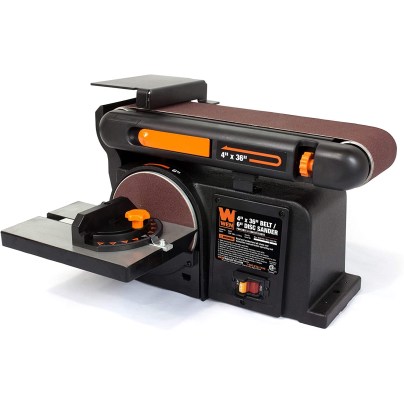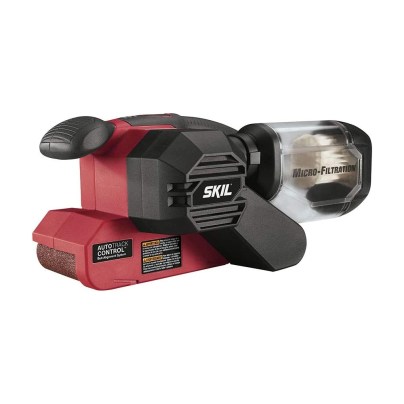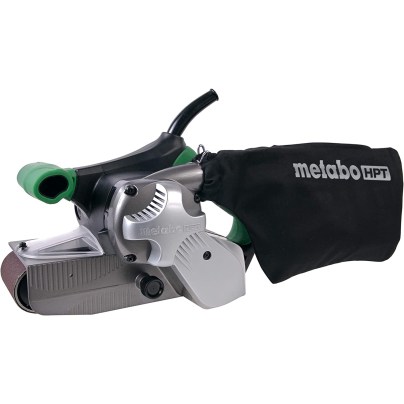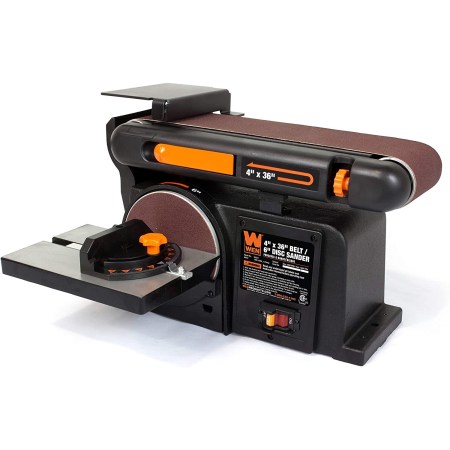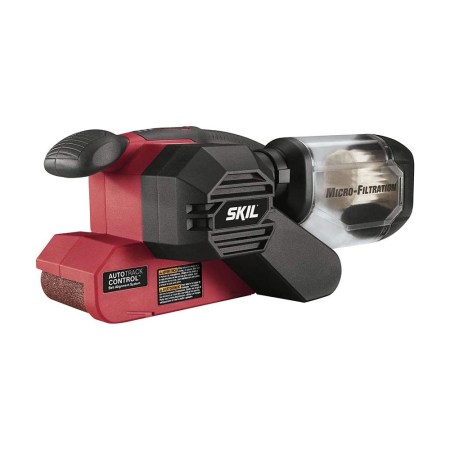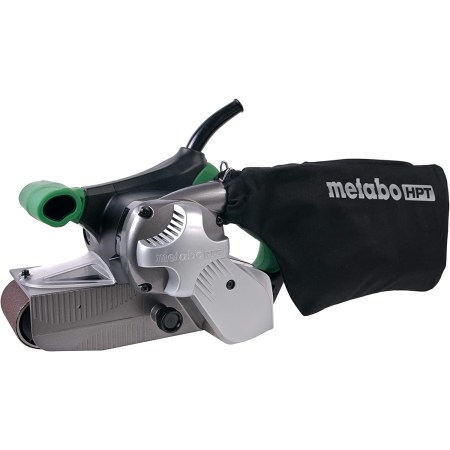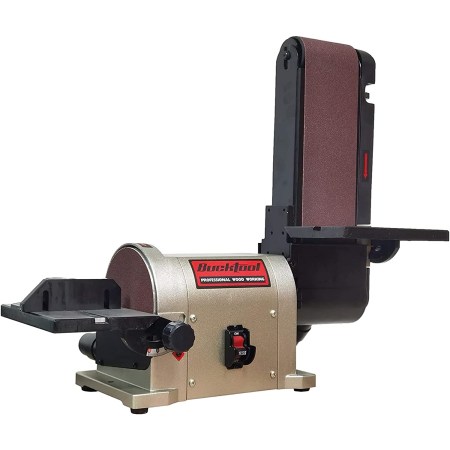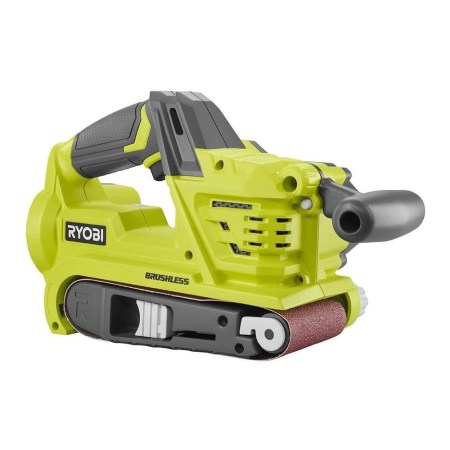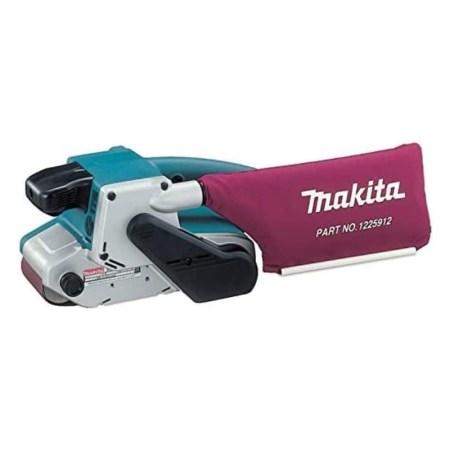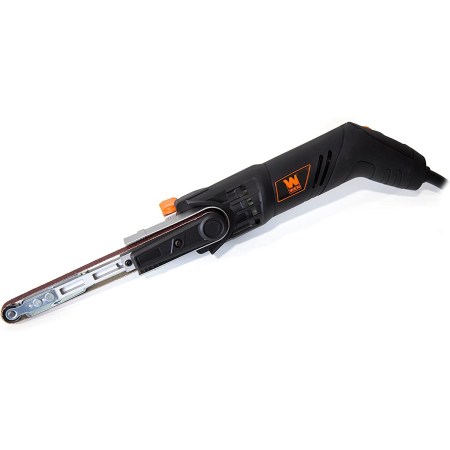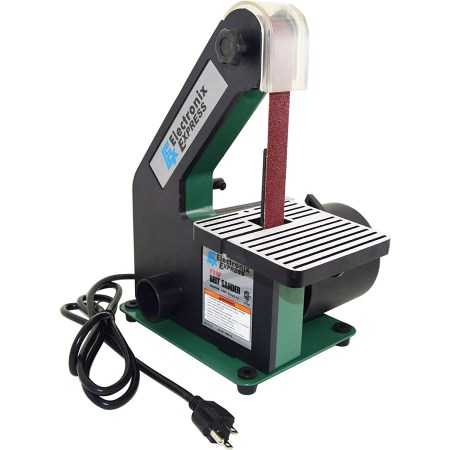We may earn revenue from the products available on this page and participate in affiliate programs. Learn More ›
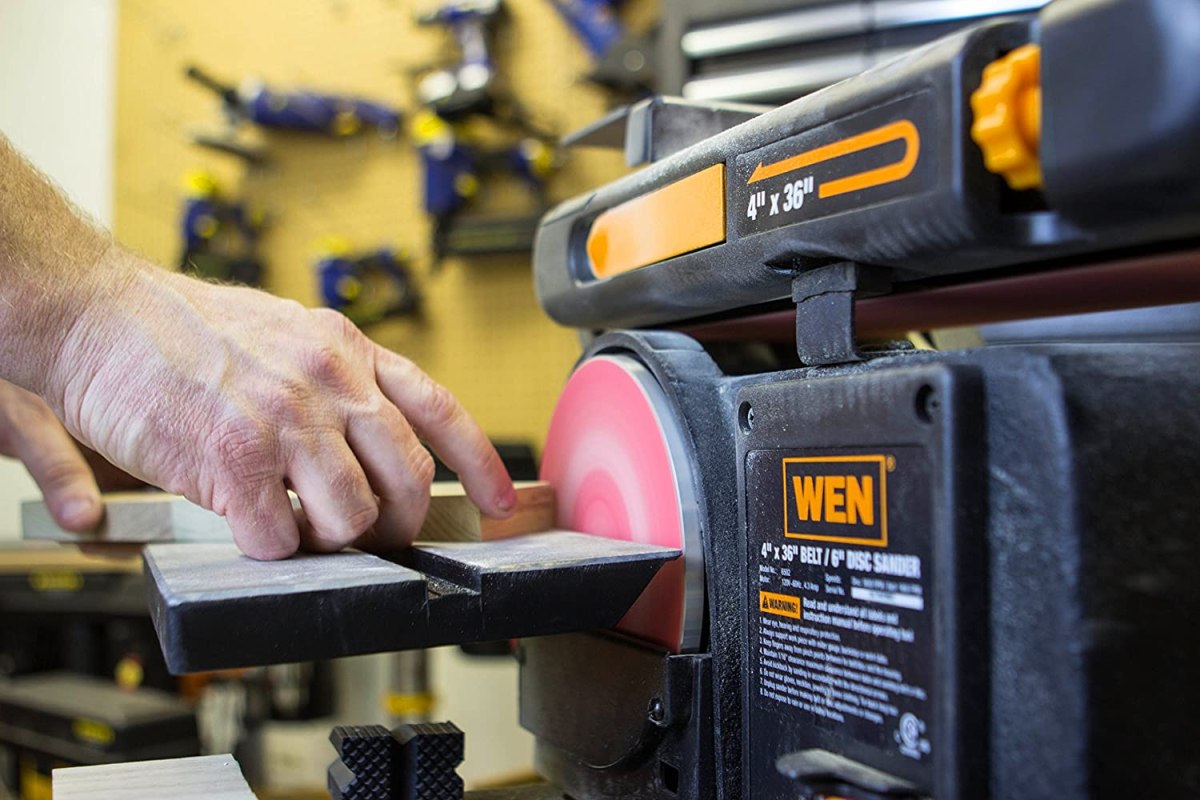
A belt sander is a relatively common power tool that is used to remove layers of wood, metal, plastic, or other target materials. This is accomplished with a cylindrical piece of sandpaper that is rapidly rotated by two or more drums, increasing the speed to the point where the sandpaper can rapidly rip through several layers. Belt sanders are powerful sanding tools that are best for sanding away layers of rough material before switching to a light-duty sander for precision work.
Given the popularity of this tool in woodworking workshops, there are many brands to choose from when it comes time to decide on the best belt sander for your next woodworking project. During your hunt for a new product, consider a DeWalt belt sander, Milwaukee belt sander, Ryobi belt sander, or just take a look at the list of top products below to find several suitable options, including a bench sander, mini belt sander, and a hand belt sander.
- BEST OVERALL: Wen 6502T 4.3-Amp 4″ x 36″ Belt and 6″ Sander
- BEST BANG FOR THE BUCK: Skil 3″ x 18″ 6.0A Belt Sander
- BEST HANDHELD: Metabo 3″ x 21″ Variable Speed Belt Sander
- BEST BENCHTOP: Bucktool Bench Belt & Disc Sander Combo | BS4603
- BEST CORDLESS: Ryobi 18V One+ Brushless Belt Sander
- BEST CORDED: Makita 9903 3″ x 21″ Belt Sander
- BEST DETAIL BELT SANDER: Wen 6307 Variable Speed Detailing File Sander
- BEST MINI BELT SANDER: Electronix Express 1″ x 30″ Mini Belt Sander
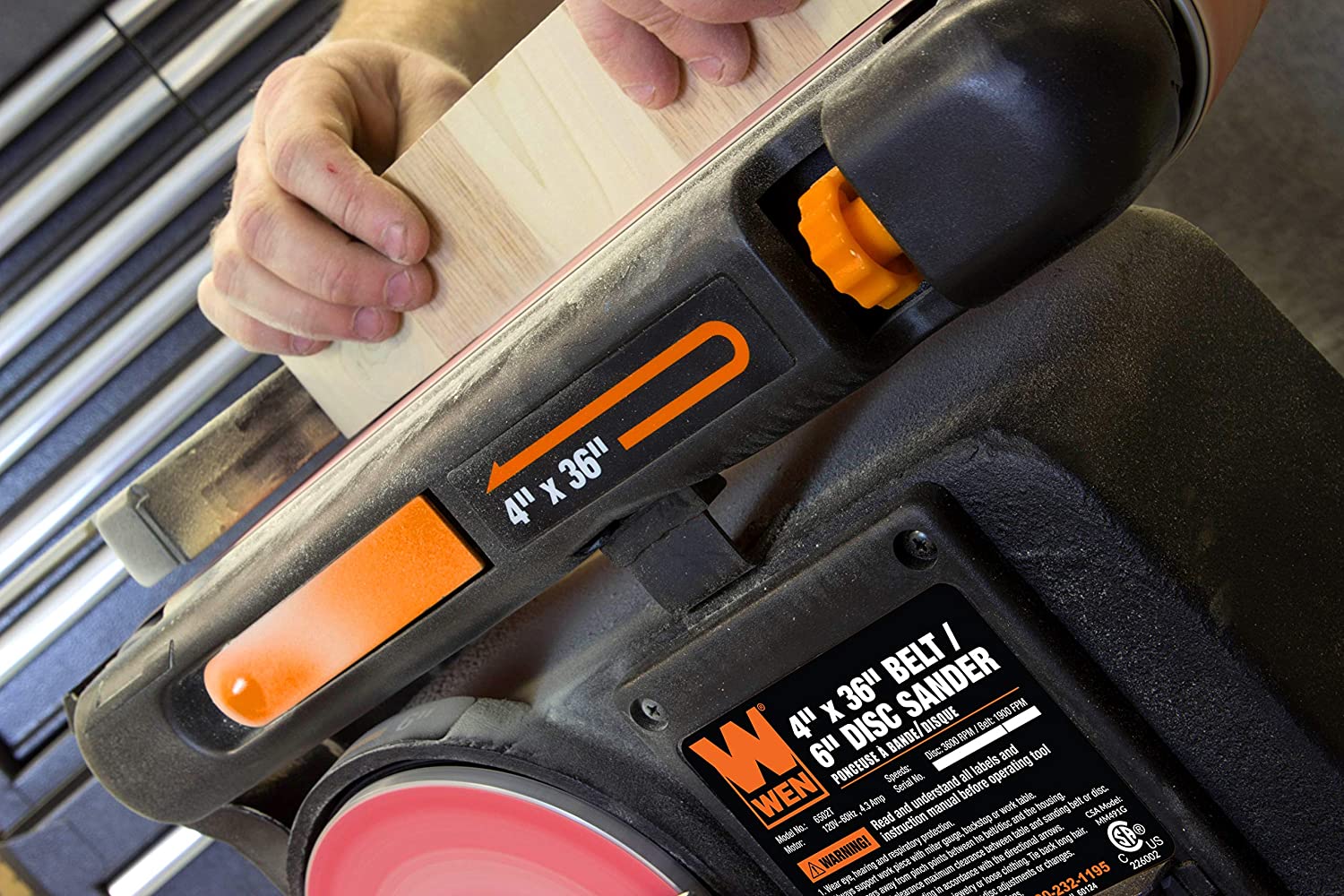
What to Consider When Choosing the Best Belt Sander
In order to find a suitable belt sander for your next woodworking project, it’s necessary to consider whether you are looking for a benchtop belt sander, a handheld belt sander, or even a completely cordless belt sander for improved maneuverability. Also, research power, speed, size, and weight so you find the best belt sander to meet your needs.
Benchtop vs. Handheld
There are two primary belt sander types, differentiated based on mobility: benchtop belt sanders and handheld belt sanders.
- Benchtop belt sanders are heavy-duty machines that are designed to sit in a stationary position on a sturdy, flat surface during operation. The user needs to bring the material to the sanding belt instead of moving the sander to the material. This makes benchtop belt sanders a great choice for sharpening knives or tools, shaping metal, sanding small woodworking projects, and more precise work.
- Handheld belt sanders are more portable than benchtop models, though many hand sanders still rely on a power cord or extension cord for electricity. Shoppers can find a small variety of cordless handheld belt sanders that really let them take advantage of the portability and mobility of the tool. However, these devices are typically less powerful than a benchtop belt sander. Use handheld belt sanders to work on larger projects, like sanding furniture or cabinets.
Motor Power and Power Source
Many tools rely on a direct connection to an electrical outlet for power, and belt sanders are no different. Most belt sanders, including both benchtop and handheld models, connect to a power outlet with a power cord or through an extension cord. This corded option offers consistent power, though it limits the range of the device. Some manufacturers also have a cordless model of belt sander that operates on battery power, though these machines are typically less powerful than a corded model. There are a few pneumatic sanders on the market, but these tools need to be connected to an air compressor, and they are not as reliable as a corded belt sander.
Typically, belt sander motors range from about 2 amps to over 10 amps, though the power output of a cordless sander is usually given in voltage, ranging from 16 to 20 volts. It should also be mentioned that some heavy-duty benchtop belt sanders require a connection to a 220-volt electrical service instead of the standard 110 volts, so be sure to check the product information before purchase.
Speed
The belt on a belt sander is driven up to high speeds using the rotational force generated by the drums. In most circumstances, the belt speed is measured in feet per minute (FPM), with a range of about 500 to 1,500 FPM. Some manufacturers provide the speed in rotations per minute (RPM), so it’s important for buyers to read the details carefully to ensure that they are understanding the information clearly.
Many belt sanders have just one fixed speed, so when users turn it on, it will take a few seconds to reach this speed; it will remain at a consistent speed until they turn it off. However, buyers can also find belt sanders with variable speed dials that allow them to control the speed at which the sander operates.
Size and Weight
A small belt sander is a good choice if you need the tool for precise detail sanding, but if you are looking for a belt sander to remove thick layers of wood or metal, then you will want a heavy-duty product. Look for a tough handheld belt sander for work on larger objects like a table or door. These devices can cause hand fatigue during use, so it’s recommended to find a product with a comfortable grip and ergonomic design to help reduce strain on the user.
Lightweight handheld sanders with broad sanding belts are a good choice if portability is necessary, but if shoppers are in the market for a benchtop belt sander, they should opt for a heavy model that won’t shift while they work. A heavy base can also help to reduce vibrations through the tool, increasing precision and control.
Additional Features
Once you have narrowed the selection to a few products using the key factors mentioned above, you can start to look for additional features, like a built-in dust collection bag, on-off trigger locks, or pressure indicators.
- Dust collection bags help to keep the work site and the project clean while users sand. The built-in vacuum system collects sawdust as it’s created instead of allowing it to sit on the surface of the target material and obscure the user’s view of the project.
- On-off trigger locks are used to increase user convenience by eliminating the need to have a finger on the trigger while sanding. Simply pull the trigger, push in the trigger lock, then release the trigger to use the belt sander without needing consistent pressure on the trigger.
- Pressure indicators provide the user with a visual prompt to indicate when the right amount of pressure is applied or if too much pressure is being applied. Typically, this is accomplished with a simple light on the sander that illuminates different colors to indicate the amount of pressure, though it can vary among products and brands.
Our Top Picks
This list of the top belt sanders was compiled from a wide pool of products and narrowed down using research and the product specs detailed above to find the best belt sanders for your next project.
Best Overall
Wen 6502T 4.3-Amp 4u0022 x 36u0022 Belt and 6u0022 Sander
See ItThe Wen 6502T two-in-one belt and disc sander is a benchtop option with a broad, heavy base to prevent the sander from shifting during use. It features a built-in dust collection port that can be connected directly to a dust collection bag or a vacuum for easy work space cleaning. The belt sander has a wide 4-inch-by-36-inch 80-grit sanding belt, while the disc sander comes with a 6-inch 80-grit sanding disc.
While the benchtop sander isn’t the right choice for sanding tables, chairs, or other large objects, it is an excellent tool for small-object tasks, like sanding chair spokes, sharpening metal tools, or even beveled sanding using the support table and removable miter gauge. The table can be tilted from 0 to 45 degrees, while the belt sander can be adjusted from 0 to 90 degrees for horizontal and vertical sanding.
Product Specs
- Speed: 1,900 FPM and 3,600 RPM
- Power: 4.3 amps
- Belt size: 4-inch-by-36-inch belt and 6-inch-by-6-inch disc
Pros
- 2-in-1 sander
- Sturdy iron base to prevent shifting
- Includes 80-grit sanding belt and 80-grit sanding disc
- Adjustable belt sander position from 0 to 90 degrees
Cons
- Limited mobility due to the power cord and benchtop design
Get the Wen 6502T belt sander at Amazon, The Home Depot, or Wen.
Best Bang for the Buck
Skil 3u0022 x 18u0022 6.0A Belt Sander
See ItThis affordable handheld belt sander is a good choice for larger projects, like sanding down a dresser, working on cabinetry, or refinishing a wooden table. It has a 3-inch-by-18-inch 80-grit sanding belt that can operate at up to 1,050 FPM. While this is a relatively low belt speed, the 6-amp motor drives the belt with enough power to make it highly effective at sanding thick layers of wood, metal, and even plastic.
Users can take advantage of the built-in micro-filtration dust collection system to suck up dust and debris while working to keep the area clear and unobscured by sawdust. The on-off trigger lock switch allows the belt sander to remain at top speed without the user needing to grip the trigger. This device also has an auto-tracking system to keep the belt centered on the sander and to prevent the sanding belt from slipping during use.
Product Specs
- Speed: 1,050 FPM
- Power: 6 amps
- Belt size: 3-inch-by-18-inch belt
Pros
- Micro-filtration dust collection system
- Affordable price
- On-off trigger with lock-on button for user convenience
- Auto-tracking belt alignment to keep the belt centered
Cons
- Low belt speed
Get the Skil belt sander at Amazon, The Home Depot, or Skil.
Best Handheld
Metabo 3u0022 x 21u0022 Variable Speed Belt Sander
See ItBenchtop belt sanders are great for smaller projects or to work on isolated pieces of a bigger project, but a handheld belt sander, like this Metabo model, is necessary to sand a larger object that cannot reasonably be lifted into position for use with a benchtop sander. The handheld belt sander has a powerful 9-amp motor and a variable speed switch that allows the user to adjust the speed of the sanding belt from 820 to 1,475 FPM.
To improve control and visibility, the belt sander has a transparent tracking window, which is especially useful when sanding in a tight space, up against a wall, or in a corner where visibility is limited. The sander collects dust in a left-side-mounted dust collection bag to help keep the work space clean and unobscured. However, despite these outstanding highlights, the belt sander is a corded device, which means that the range and portability are limited by the power cord.
Product Specs
- Speed: Variable speed from 820 to 1,475 FPM
- Power: 9 amps
- Belt size: 3-inch-by-21-inch belt
Pros
- Powerful 9-amp motor
- Variable speed settings
- Built-in tracking window improves visibility
- Left-side-mounted dust collection bag
Cons
- Limited range due to corded design
Get the Metabo belt sander at Amazon, Lowe’s, or Metabo
.
Best Benchtop
Bucktool Bench Belt u0026 Disc Sander Combo | BS4603
See ItUsing a handheld belt sander for small projects or isolated parts is difficult because you need two hands to hold the belt sander, while the target object must be secured in a vise. Instead of rigging up this system, opt for a benchtop model, like the Bucktool Belt & Disc Sander. The benchtop belt sander remains stationary, while the user moves the target material to the rapidly moving sanding belt to sand, shape, or sharpen.
The direct-drive motor system improves sanding efficiency, while the heavy base prevents the sander from slipping or shifting during use. Adjust the belt sander orientation from 0 to 90 degrees for both horizontal and vertical sanding, or tilt the aluminum work table up to 45 degrees for beveled sanding with the built-in disc sander. Just keep in mind that this stationary tool is not designed for portability.
Product Specs
- Speed: 2,161 FPM and 3,450 RPM
- Power: 5 amps
- Belt size: 4-inch-by-36-inch belt and 6-inch-by-6-inch disc
Pros
- 0- to 90-degree belt sander adjustment
- 0- to 45-degree aluminum work table tilt
- 2-in-1 benchtop sander
- Direct drive motor increases sanding efficiency
Cons
- Stationary setup is not intended for portability
Get the Bucktool belt sander on Amazon or Bucktool.
Best Cordless
Ryobi 18V One+ Brushless Belt Sander
See ItOne of the most common problems in a crowded workshop is dealing with the constant tripping hazard created by corded power tools. While benchtop tools can be set up, plugged in, and positioned to limit this issue, handheld power tools need to be carried and moved around the workshop. Investing in a cordless belt sander is a good way to eliminate this safety hazard and increase versatility and control.
This cordless Ryobi belt sander comes with a 3-inch-by-18-inch 80-grit sanding belt and a dust collection bag. It also features an on-off trigger-lock switch and an adjustable pommel handle for better handling. However, this cordless model can only reach speeds of 850 FPM, and it does not come with a battery or a charger, so users will need to purchase these accessories separately.
Product Specs
- Speed: 850 FPM
- Power: 18 volts
- Belt size: 3-inch-by-18-inch belt
Pros
- Portable design isn’t hindered by a power cord
- Includes 80-grit sandpaper belt and a dust collection bag
- Adjustable pommel handle and overmold grip for increased control
- On-off trigger with lock-on button for user convenience
Cons
- Limited power and speed
- Battery is not included
Get the Ryobi belt sander at The Home Depot or on Amazon.
Best Corded
Makita 9903 3u0022 x 21u0022 Belt Sander
See ItConsistent power is important while working with a belt sander because if the power cuts out or fluctuates partway through the project, the speed of the belt slows, resulting in uneven patches across the surface of the material. This corded handheld belt sander is the ideal solution, with a powerful 8.8-amp motor and a long 16.4-foot power cord that can be connected to an extension cord for increased range.
The auto-tracking belt-alignment system helps to prevent the 3-inch-by-21-inch sanding belt from slipping during use, while the included dust collection bag serves to keep the area clean and clear of sawdust. Users can also take advantage of the variable speed settings that range from 690 to 1,440 FPM for increased control while they work.
Product Specs
- Speed: Variable speed from 690 to 1,440 FPM
- Power: 8.8 amps
- Belt size: 3-inch-by-21-inch belt
Pros
- Powerful 8.8-amp corded performance
- Includes a heavy-duty dust collection bag
- Auto-tracking belt alignment to keep the belt centered
- Variable speed setting for improved control
Cons
- Limited portability
Get the Makita belt sander on Amazon or at The Home Depot.
Best Detail Belt Sander
Wen 6307 Variable Speed Detailing File Sander
See ItNot every belt sander is designed for broad-stroke sanding applications. This detail belt sander by Wen has a very narrow sanding belt that measures just 18 inches long and 0.5 inches wide. The narrow sanding belt is used to get into tight spaces, corners, and gaps where other sanders cannot reach, but it’s also intended for detail and finish sanding.
The belt is made to pivot up to 55 degrees for optimal positioning, and it features an auto-tracking belt system that does not require tensioning or adjustment. This product operates with a variable speed dial that can be set from 1,080 to 1,800 FPM. The rapid speed makes this device ideal for creating smooth, finished surfaces, though the narrow sanding belt is not suitable for dealing with larger objects.
Product Specs
- Speed: Variable speed from 1,080 to 1,800 FPM
- Power: 2 amps
- Belt size: 0.5-inch-by-18-inch belt
Pros
- Rapid belt speed for detail sanding
- Narrow belt is easy to maneuver in tight spaces
- Auto-tracking belt system requires no tensioning or adjustment
- Pivots up to 55 degrees for versatile sanding
Cons
- Not suitable for sanding large surfaces
Get the Wen 6307 belt sander at Amazon, The Home Depot, or Wen.
Best Mini Belt Sander
Electronix Express 1u0022 x 30u0022 Mini Belt Sander
See ItThere are a wide variety of metal tools that are used in the workshop, in the kitchen, and around the home, like chisels, knives, or axes. However, these tools can become dull with regular use, limiting their ability to cut, chip, or slice. To solve this problem, this mini belt sander has a narrow vertical sanding belt that is ideal for sharpening metal tools.
The 1-inch-by-30-inch sanding belt is also suitable for small wooden projects or isolated pieces of a larger item, like the spindles of a chair. It runs at a speed of 3,400 RPM, allowing it to create smooth finished surfaces, and the benchtop table can be tilted up to 45 degrees. The benchtop belt sander is a great choice for detail sanding, finish sanding, and tool sharpening, but it isn’t the right option for users who need a portable belt sander.
Product Specs
- Speed: 3,400 RPM
- Power: 3 amps
- Belt size: 1-inch-by-30-inch belt
Pros
- Narrow sanding belt for detailed projects
- Table tilts up to 45 degrees
- Includes an 80-grit sanding belt
- Ideal for sharpening cooking knives
Cons
- Benchtop model isn’t intended for portability
Get the Electronix Express belt sander on Amazon.
Our Verdict
The Wen 6502T belt sander is a great option for DIYers who need more than one type of sander in the workshop due to the two-in-one design, but if you are looking for a lightweight handheld belt sander, the Skil belt sander is an excellent choice at an affordable price.
How We Chose the Best Belt Sanders
The task of selecting the best belt sanders was only possible through in-depth research into a wide variety of options in order to identify the range of speed, power, and versatility offered by this pool of products. Belt sanders are best known for being heavy-duty sanding tools that can remove thick layers of wood and metal to prep the project for detail or finish sanding. With this in mind, the top products needed to have enough power to chew through tough materials.
It was also necessary to select more versatile belt sanders that could be used to work in tight spaces or for detailed sanding, so the list includes several handheld belt sanders and even a cordless belt sander for superior portability. Some products boasted a two-in-one design, giving users the choice between a belt sander or a disc sander, while other belt sanders included extra features, like a dust collection bag, to help them stand out from similar products. The product specs, additional features, and unique product highlights were used to determine the best belt sanders for this comprehensive list.
Tips for Using Belt Sanders
Whenever you are using a belt sander, it’s recommended to use appropriate personal protective equipment consisting of closed-toe shoes, long pants, a long-sleeve shirt, safety glasses, a mask, and gloves. Make sure the space is well ventilated and that there is enough light to work on the project safely.
Regardless of whether you are sanding wood, metal, or any other material, make sure to move the handheld belt sander at a consistent pace in order to prevent damage to your project. Similarly, if you are using a benchtop sander, you need to move the material at a consistent pace and pressure. Also, make sure the benchtop sander has a flat, stable surface to sit on during use. This will help reduce vibrations and increase precision.
- Use appropriate personal protective equipment when operating a belt sander.
- Move the sander at a consistent pace to prevent oversanding or uneven patches.
- Benchtop belt sanders need a flat, sturdy surface to avoid shifting during use.
FAQs
If you still aren’t sure how to choose the best belt sander, the following answers to some of the most common questions about belt sanders may help you gain a better understanding of how and when to use a belt sander.
Q. How do I use a belt sander?
Use a belt sander by plugging it in and turning it on or attaching the battery and turning it on. Give the sander a few seconds for the sanding belt to get up to the set speed. If you are using a handheld belt sander, lower the sander to the target material with a slight forward motion. The belt will immediately grab at the material when it comes in contact, so it’s necessary to have a firm grip on the sander to prevent it from slipping out of your hands.
If you are using a benchtop sander, lower the material to the sander, keeping in mind that the rapidly moving belt will rip the material from your hands if you don’t have a firm grip. Work the sander with the grain of the wood and avoid leaving the sander or the target material in one place for too long, as this can result in oversanding.
Q. When should I use a belt sander?
A belt sander is a powerful tool used to trim edges, level surfaces, and shape materials. Typically, this tool is intended to remove thick layers of wood and metal to prepare the project for detailed sanding, though some precision belt sanders are suitable for light-duty finishing projects.
Q. How long do belt sander belts last?
The belt on a belt sander lasts about 12 to 18 months, depending on the frequency of use. However, the actual belt sander will last between 5 and 10 years if it is properly maintained, cleaned, and stored when not in use.
